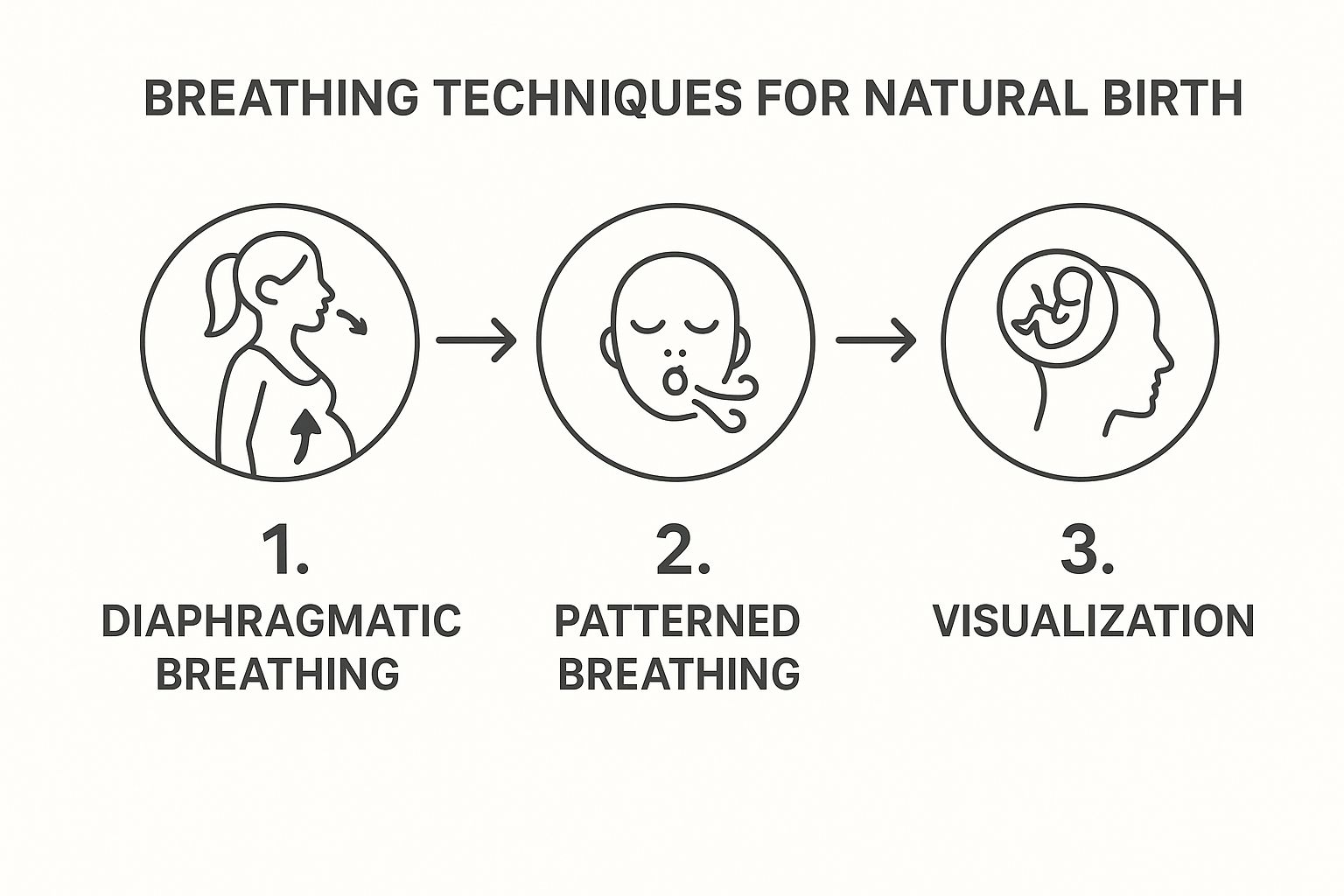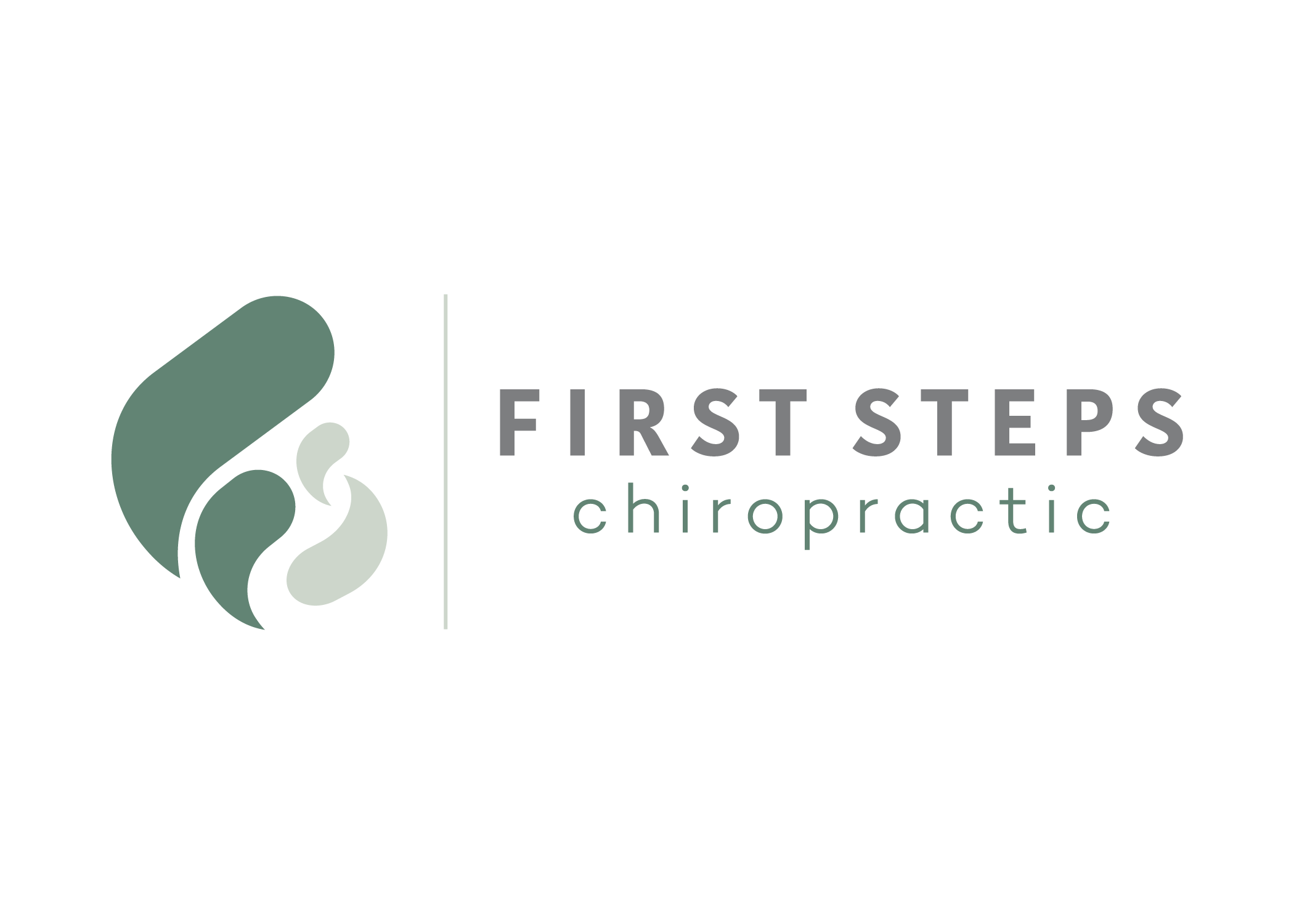Thinking about a natural birth isn’t just about trying to skip the medication. It’s about building a deep sense of trust in your body’s ability to do its incredible work. The real goal is to feel informed, strong, and ready for whatever your labor journey brings.
Your Empowered Path to Natural Childbirth
So, you’re ready to prepare for a natural birth. Fantastic. This is about so much more than just aiming for a delivery without an epidural. It’s about stepping into your labor feeling prepared, confident, and truly present for the experience. Let’s walk through the real-world strategies that get your body and mind ready for this amazing journey.

A Foundation of Empowerment and Safety
The modern path to natural birth beautifully blends time-tested wisdom with the incredible safety net of modern medicine. It’s important to acknowledge how far we’ve come. Historically, before modern medical care was available, the natural maternal mortality rate was a sobering 1,500 per 100,000 births. Even in the early 1900s in the U.S., that number was around 700 per 100,000. These figures underscore why preparing within a safe, supportive environment is so important.
Today, we have the best of both worlds. The goal is to create an experience that is both deeply empowering and fundamentally safe. It’s about making informed choices—from where you give birth to who is on your team—so you feel heard and respected every step of the way.
This guide is here to be your supportive partner through it all. We’ll cover all the essential pillars of preparation:
- Physical Conditioning: We’ll look at targeted exercises and specialized chiropractic care to get your body physically ready for labor.
- Mental Resilience: You’ll learn practical techniques to build a focused and unshakable mindset for the challenges of labor.
- Nutritional Support: We’ll dive into the foods that can boost your stamina and support healthy tissues.
- Strategic Planning: I’ll help you craft a birth plan that clearly and effectively communicates your wishes to your entire care team.
The Role of Chiropractic Care
One of the most powerful, yet often overlooked, parts of physical preparation is making sure your pelvis is properly aligned. Think of it this way: a balanced pelvis creates more room for your baby to get into the best possible position for birth. This can make a huge difference in how labor progresses.
Specific methods, like the Webster Technique, are designed precisely for this purpose. It’s a gentle, safe, and effective way to promote pelvic balance during pregnancy. If you want to dive deeper into this, you can learn more about the power of the Webster Technique for pregnancy in our detailed article.
My hope is to show you that with dedicated preparation, a natural birth is a truly powerful and achievable goal. Let’s get started on building the physical strength, nutritional foundation, and confident mindset you’ll need.
Building A Strong Body For Labor
Physical readiness is a huge piece of the puzzle when you’re preparing for a natural birth. This isn’t about training for a marathon, but about smart, targeted conditioning. The goal here is to build up your stamina for the incredible work of labor and, just as importantly, to encourage your pelvis to be in the best possible alignment. This gives your baby the clearest, most open path into the world.
Think of your body as the vessel for this amazing event. Just like you’d prepare for any big physical challenge, specific movements can make a world of difference. When you feel physically prepared, you also feel more capable, powerful, and ready to meet the intensity of labor head-on.
The Power Of Pelvic Alignment
One of the most impactful things you can do for your birth preparation is to focus on balancing your pelvis. A well-aligned pelvis simply creates more space, which can be the deciding factor in helping your baby get into that ideal head-down position. When your body is aligned, it often leads to a more efficient and smoother birthing process.
This is exactly where specialized chiropractic care comes in. The Webster Technique is a gentle, safe chiropractic method designed specifically for pregnancy. It focuses on reducing tension in the pelvic muscles and ligaments to help restore normal function. It’s not about “turning” a breech baby; it’s about creating the ideal internal environment for your baby to find their best position all on their own.
A balanced pelvis isn’t just for comfort during pregnancy—it’s about creating a clear, open pathway for your baby. The Webster Technique is a proactive step you can take to facilitate an easier birth by addressing your body’s biomechanics before labor even begins.
Daily Exercises For Labor Preparation
Bringing simple, targeted exercises into your daily routine can significantly boost your strength and flexibility. Remember, consistency is far more important than intensity. These movements directly support the muscles you’ll be relying on during labor and delivery.
Some of the most effective exercises I recommend include:
- Deep Squats: Did you know that squatting can open the pelvic outlet by up to 28%? That’s a lot more room for your baby to descend! Try holding a deep squat for 30-60 seconds each day, using a wall or a sturdy chair for support.
- Pelvic Tilts (Cat-Cow): This gentle movement, done on your hands and knees, is fantastic for spinal mobility and can really help with that common low back pain. It also encourages your baby into an anterior position (with their back against your belly), which is ideal for birth.
- Butterfly Stretches: Sit on the floor, bring the soles of your feet together, and gently press your knees toward the ground. This is a wonderful stretch for your inner thighs, groin, and hips.
For more ideas on movements that support your changing body, you can explore these safe exercises and stretches for pregnancy.
The Role Of Perineal Massage
Another practical preparation you can start at home is perineal massage. Beginning around 34-36 weeks, this technique involves gently massaging the perineum—the area of tissue between the vaginal opening and the anus—to help increase its elasticity.
Studies show that regular perineal massage can be especially helpful for first-time mothers. It’s been linked to a reduced risk of significant tearing and the need for an episiotomy. The idea is to familiarize your body with the sensation of stretching and help those tissues become more pliable ahead of time.
- How to Do It: Use a natural oil (like vitamin E or coconut oil) and your thumbs to apply gentle, steady pressure downward and outward for just a few minutes each day.
- The Benefit: Think of it as patient, gentle practice. You’re teaching your body’s tissues how to yield under pressure in a calm setting, which can make the actual stretching during crowning feel less alarming and more manageable.
To give you a clearer picture of how this all fits together, here’s a sample weekly schedule.
Third Trimester Physical Prep Schedule
Here is a sample schedule to help you visualize how to integrate key physical preparation activities into your week during the third trimester.
| Day | Main Activity (30-45 mins) | Supporting Practice (5-10 mins) |
|---|---|---|
| Monday | Prenatal Yoga or Brisk Walk | Deep Squats (3 sets of 30-60 seconds) |
| Tuesday | Chiropractic Adjustment (Webster Technique) | Perineal Massage |
| Wednesday | Strength (Cat-Cow, Butterfly Stretches, Pelvic Tilts) | Mindful Breathing Exercises |
| Thursday | Brisk Walk or Swimming | Perineal Massage |
| Friday | Prenatal Yoga or Gentle Stretching | Deep Squats (3 sets of 30-60 seconds) |
| Saturday | Active Rest (Long, gentle walk) | Perineal Massage |
| Sunday | Rest & Mind-Body Connection (Meditation, Visualization) | Gentle Butterfly Stretches |
This is just an example, of course. The most important thing is to listen to your body and find a rhythm that feels good for you.
Integrating Mindful Movement And Breathing
Physical prep isn’t just about the muscles; it’s deeply connected to your mind. Activities like prenatal yoga are brilliant because they combine physical postures with the breathing techniques you’ll need to manage labor.
This infographic lays out a simple flow of breathing techniques that are fundamental for a natural birth.

As you can see, the key is to move from deep, calming belly breaths in early labor to more focused, patterned breathing as the intensity builds. Using visualization alongside your breath helps you stay centered and in control.
By practicing these exercises, seeking pelvic alignment, and mindfully connecting with your body, you are building a powerful physical foundation. You’re not just passively hoping for a smooth birth—you are actively, step-by-step, preparing for one. This physical work builds more than just strength; it builds unshakeable confidence in your body’s inherent ability to give birth.
The Best Foods for Your Natural Birth Prep

When you’re preparing for a natural birth, what you eat becomes one of your most powerful tools. Your diet can directly influence your energy levels, tissue health, and the delicate hormonal dance that gets labor started. This isn’t about just “eating healthy”—it’s about making strategic food choices to fuel your body for the incredible work ahead.
Think of your third trimester as the training period for an endurance event. You’re building the stamina you’ll need for the marathon of labor, so loading up on nutrient-dense foods is absolutely key. These foods provide the essential building blocks for strength, resilience, and a smoother recovery.
Powering Up with Labor-Specific Nutrients
As your due date gets closer, certain nutrients take center stage. You’ll want to focus on foods that support muscle function, build up your iron stores to combat fatigue, and promote tissue health to help with stretching and healing.
Two of the biggest players here are iron and protein. Iron is crucial for creating hemoglobin, the protein in red blood cells that carries oxygen to all your muscles—especially your uterus. Ample protein is essential for tissue elasticity, which is incredibly important for your perineum and cervix during delivery.
Here are some excellent sources to work into your diet:
- Iron-Rich Foods: For iron that’s easily absorbed, focus on heme iron from sources like lean red meat, poultry, and fish. If you’re plant-based, turn to spinach, lentils, beans, and fortified cereals. Just be sure to pair them with a source of vitamin C (like bell peppers or oranges) to maximize absorption.
- High-Quality Protein: Eggs, Greek yogurt, chicken, fish, and legumes are all fantastic choices. These proteins help build and repair tissues, giving your body the foundational strength it needs.
The Evidence Behind Power Foods
Beyond the basics, a few specific foods have earned a reputation for their benefits in labor preparation. While they aren’t magic bullets, the research and traditional wisdom behind them are pretty compelling.
Dates are one of the most talked-about foods for a reason. Some studies suggest that eating dates in the final weeks of pregnancy can lead to a more favorable labor. The theory is that dates may help ripen the cervix and enhance uterine contractions, potentially reducing the need for medical induction.
A Note on Dates: One study found that women who consumed six dates per day for the four weeks leading up to their due date were significantly more dilated when they arrived at the hospital and had a lower rate of induction compared to those who didn’t.
Red raspberry leaf tea is another classic. Often called a “uterine tonic,” this tea is thought to help tone the uterine muscles, which may lead to more effective contractions once labor begins. It’s generally considered safe in the third trimester, but as with anything, it’s smart to chat with your provider before you start drinking it regularly.
A Sample Third-Trimester Meal Plan
Trying to put this all together can feel a bit overwhelming, so here’s what a day of nutrient-dense eating might look like. Think of this as a template to spark ideas for getting those key foods into your routine.
| Meal | Example | Nutritional Benefit |
|---|---|---|
| Breakfast | Oatmeal made with milk, topped with berries, chia seeds, and a handful of walnuts. | Complex carbs for sustained energy, plus fiber, antioxidants, and healthy fats. |
| Lunch | A big spinach salad with grilled chicken, chickpeas, bell peppers, and a lemon-tahini dressing. | A great mix of iron, protein, and vitamin C to support energy and tissue health. |
| Snack | A couple of Medjool dates stuffed with almond butter and a cup of red raspberry leaf tea. | The powerhouse date-and-tea combo for uterine and cervical preparation. |
| Dinner | Baked salmon with roasted sweet potatoes and steamed broccoli. | Omega-3s for brain health, plus beta-carotene and essential vitamins. |
Ultimately, your best strategy is a balanced diet filled with whole foods. By focusing on iron, protein, and these evidence-backed “power foods,” you are actively nourishing your body and setting yourself up for a strong, empowered natural birth. And don’t forget to stay hydrated and listen to your body’s cues—it knows what it needs.
Developing an Unshakable Mindset for Labor
While all the physical prep lays the groundwork, the real secret to a positive natural birth often lies in your mind. Your mental and emotional state is every bit as crucial as your physical readiness. Let’s be real—labor is an intense, powerful event. Building up your psychological resilience is what helps you navigate its rhythm with confidence instead of fear.
This isn’t about pretending labor won’t be intense. It’s about building a toolkit to meet that intensity head-on. It’s about cultivating a calm, focused, and powerful internal space, no matter what your labor decides to throw your way. So, let’s get into the practical strategies you can start using today.
Reframing Your Perspective on Pain
One of the most profound mental shifts you can make is to completely change how you think about the sensations of labor. In everyday life, pain screams “Something is wrong!” But in labor, those intense sensations are signs of incredible progress—they are productive and purposeful.
Every single contraction is your body working with beautiful efficiency to open your cervix and bring your baby down to you. When you feel a surge building, instead of tensing up and fighting it, try to lean into it. Visualize your muscles working just as they should, and picture your baby making their way down. This simple reframing can transform your experience from one of suffering into one of powerful, active participation.
Think of contractions not as “pain,” but as “power.” They are surges of energy with a specific job to do. Viewing them this way helps you work with your body, not against it. This mindset shift is fundamental to preparing for a natural birth.
Mastering Your Breath
Your breath is your anchor. I can’t stress this enough—it is the single most powerful tool you have to stay centered, manage sensations, and keep your body relaxed and flooded with oxygen. When we get tense, our bodies release stress hormones that can actually work against the natural flow of labor. Calm, rhythmic breathing does the exact opposite.
It’s a great idea to have a few different breathing patterns in your back pocket, because what works in early labor might not be what you need during transition.
- Slow, Deep Breathing: This is your foundation. Inhale slowly through your nose for a count of four, letting your belly expand, then exhale even more slowly through your mouth for a count of six or eight. Use this during early labor and in the quiet moments between contractions.
- Patterned Breathing: As things pick up, you might find a lighter, faster rhythm feels better. Some people like a “hee-hee-hoo” pattern, while others prefer a light panting-style breath. The key is to find a rhythm that feels right and, most importantly, prevents you from holding your breath.
Start practicing these techniques now, in your daily life. Stuck in traffic? Stressed at your desk? Turn to your breath. The more it becomes your automatic response to stress, the more instinctively you’ll use it during labor.
The Power of Visualization and Affirmations
What you see in your mind’s eye can have a massive impact on your body. Visualization is more than just daydreaming; it’s an active technique where you create detailed, positive mental images to help guide your body through the work of labor. It can make you feel much more in control of the process.
Here are a few visualizations I often suggest to clients:
- Imagine your cervix as a flower, like a rosebud, that is slowly and gently blooming open with each and every contraction.
- Picture each surge as a wave in the ocean. You can breathe in as the wave builds, ride it to its peak, and then breathe out as it smoothly recedes. You are not the wave; you are the strong, graceful surfer riding it.
- Visualize a warm, golden light filling your entire body, relaxing every single muscle it touches.
Affirmations are your personal cheerleading squad. They are simple, positive statements you repeat to yourself to reinforce your belief in your own ability to give birth. They are incredibly effective at overriding those fear-based thoughts that can creep in. Pick phrases that truly resonate with you.
Examples of Powerful Birth Affirmations:
- “My body was designed to do this.”
- “I trust my instincts to guide me.”
- “Each surge brings me closer to my baby.”
- “I am strong, capable, and powerful.”
- “I release all fear and welcome my baby.”
Write your favorites on sticky notes and put them everywhere—on your bathroom mirror, by your bed, on the dashboard of your car. Read them aloud every day until they feel like an undeniable truth.
Exploring Philosophies Like Hypnobirthing
You don’t have to go all-in on one philosophy to benefit from its wisdom. Methods like Hypnobirthing offer some fantastic techniques that any birthing person can learn and adapt. The core idea is to achieve a state of deep relaxation, which allows your body to birth without the resistance that fear and tension create.
Hypnobirthing focuses on self-hypnosis, specialized breathing, and visualization exercises designed to help you release fear and trust your body’s innate birthing instincts. Even just borrowing a few of its core principles—like using calming music, choosing specific positive language to describe labor, and listening to deep relaxation scripts—can dramatically improve your mindset. Looking into these approaches can add some incredibly valuable tools to your mental toolkit.
How to Create a Practical Birth Plan
Let’s talk about birth plans. They sometimes get a bad rap, viewed as this rigid, unyielding script for what is, by nature, a totally unpredictable event. But that’s missing the point. The real power of a birth plan isn’t in creating some unbreakable contract; it’s in the process of creating it.
The real value comes from the research you do, the questions you find yourself asking, and the crucial conversations it sparks between you, your partner, and your care provider. Think of it less like a rulebook and more like your most important communication tool—a roadmap for your journey.

This simple document transforms you from a passive patient into an active, informed participant in your own birth story. It makes sure that when you’re deep in the hard work of labor, your entire team understands your preferences, helping you feel heard, respected, and genuinely supported.
Beyond a Checklist: What to Include
A great birth plan goes so much deeper than just “epidural: yes/no.” It should paint a picture of your ideal birth experience, covering everything from the atmosphere in the room to your go-to coping strategies and your wishes for both you and your baby right after delivery. A well-rounded plan helps everyone get on the same page about what matters most to you.
Remember, this needs to be easy to read. Think bullet points and clear headings, not dense paragraphs. The on-call nurse who has never met you before should be able to glance at it and grasp your key wishes in under 60 seconds.
Here are some essential areas to think through:
- Your Labor Environment: What makes you feel calm and safe? Consider lighting (do you prefer it dim?), music or silence, and how many people you want in the room.
- Pain Management Preferences: Detail the non-medical techniques you want to try first. This could be movement, getting in the shower or tub (hydrotherapy), or using counter-pressure.
- Labor Support: Who is your team? Clarify the roles of your partner, doula, or anyone else supporting you. How, specifically, do you want them to help?
- Medical Interventions: This is a big one. State your preferences on topics like fetal monitoring (intermittent vs. continuous), artificially breaking your water, and interventions to speed up labor.
- Pushing and Delivery: Would you prefer to be guided by your own body’s urges to push? Are there specific positions, like squatting or hands-and-knees, you’d like to try?
- Immediate Postpartum Care: Include your wishes for that precious “golden hour” after birth, like immediate skin-to-skin contact and delayed cord clamping.
By thoughtfully considering these points ahead of time, you’re preparing yourself for the decisions that might come up during labor.
The Power of Collaborative Phrasing
The language you use in your birth plan is incredibly important. Instead of handing over a list of demands, try framing your preferences in a collaborative and respectful way. This approach fosters a partnership with your medical team rather than creating an us-vs-them dynamic.
Key Takeaway: A birth plan isn’t about controlling every single outcome. It’s about taking ownership of your experience, understanding your options, and creating a framework for informed, shared decision-making with your care team.
For instance, writing “NO IV” can sound confrontational. A more collaborative phrase would be, “I would prefer to avoid a routine IV and stay hydrated orally. I am open to discussing the need for an IV if a specific medical reason arises.” This shows you’re informed, but also flexible and reasonable.
Here’s how you can rephrase common preferences to build a better partnership:
| Instead of This (Demanding) | Try This (Collaborative) |
|---|---|
| “I will not be on my back to push.” | “I would like the freedom to move and find the pushing position that feels most effective for me. I am open to suggestions from the team.” |
| “Do not offer me pain medication.” | “My goal is an unmedicated birth. Please support me with non-pharmacological pain relief methods first. I will let you know if I change my mind.” |
| “No students in the room.” | “We would appreciate it if you would ask for our consent before allowing any students or observers to be present for our birth.” |
This subtle shift in tone can make a world of difference in how your plan is received.
Backing Your Plan with Knowledge
At its core, the process of creating a birth plan is an educational one. As you research each point, you become more knowledgeable about the entire birth process, including how one intervention can cascade into another. Understanding all your options, like the difference between traditional and pregnancy-focused chiropractic care, is part of this comprehensive preparation.
This education is a cornerstone of preparing for a natural birth, and its impact is statistically significant. A 2023 study found that women who created birth plans as part of their antenatal education had a vaginal birth rate of 81.9%, compared to just 48.7% for those without that preparation. The odds of having a vaginal birth were over 4.7 times higher for women with a plan. That shows just how crucial informed planning is. You can explore the full findings to understand more about the impact of birth plans on outcomes.
By taking the time to create a thoughtful, flexible, and well-communicated birth plan, you are setting the stage for a positive and empowered experience, no matter how your unique birth story unfolds.
Common Questions About Natural Birth Prep
As you get closer to meeting your baby, it’s completely normal for questions to pop up. In fact, it’s a great sign! It means you’re taking an active role in your birth experience. Getting solid, clear answers is one of the best ways to build the confidence you’ll need on the big day.
Let’s walk through some of the questions we hear most often from expecting parents.
When Is The Best Time To Start Preparing For A Natural Birth?
While a healthy lifestyle is fantastic throughout your entire pregnancy, the focused, intentional prep usually ramps up in the third trimester. I often tell my patients to think of the 28-32 week mark as the sweet spot for diving into childbirth classes, really practicing those breathing techniques, and getting your mental game strong.
More hands-on physical prep, like perineal massage, is usually best started a bit later, around 34-36 weeks. Of course, any work you do earlier—like establishing good nutrition, gentle movement, and pelvic-focused care like the Webster Technique—will only set you up for greater success when you hit that final stretch. It all builds on itself.
Can I Have A Natural Birth After A Cesarean?
Yes, absolutely. A Vaginal Birth After Cesarean (VBAC) is a safe and incredibly empowering choice for many women. A huge factor in a successful VBAC is finding a care provider and birth location that are genuinely on board with your goals and will support you. The American College of Obstetricians and Gynecologists even supports VBAC as a reasonable option for many women.
Your preparation will look a lot like any other natural birth prep—focusing on physical readiness, building mental resilience, and mapping out your birth preferences. The main difference is you’ll have an added layer of listening to your body’s unique history. I highly recommend connecting with VBAC support groups, either locally or online. The practical advice and encouragement from women who have been in your exact shoes is invaluable.
What Is The Role Of A Doula In A Natural Birth?
A doula provides continuous emotional, physical, and informational support before, during, and right after birth. For families aiming for a natural birth, a doula’s role is often seen as essential. They are a non-medical professional whose entire focus is on your comfort, your emotional state, and your experience.
During labor, a doula is your hands-on expert in comfort measures. They know when to suggest a new position to help things progress, how to apply the perfect counter-pressure on an aching back, and how to just be a steady, reassuring presence in the room. They also serve as an advocate, helping you voice your preferences and making sure you have the information you need to make decisions along the way.
A doula doesn’t take the place of your partner; they make the whole team stronger. Their presence allows your partner to focus on supporting you emotionally, without the pressure of remembering every single comfort technique. It often leads to a more connected experience for both of you.
The research backs this up, consistently showing that continuous doula support is linked to better outcomes, including:
- Shorter labors
- Fewer requests for epidurals
- Lower rates of medical interventions
- Higher satisfaction with the birth experience
What If My Labor Does Not Go According to My Plan?
This is probably the most important question of all, and it gets right to the heart of mental preparation. The goal of preparing isn’t to force a “perfect” birth but to feel empowered, respected, and in control no matter how your story unfolds.
Think of your birth plan as a roadmap, not a rigid script. The real power comes from the knowledge you gain and the coping skills you develop during your prep. Those tools are yours to keep, no matter which path your labor takes. If medical support becomes necessary, your preparation ensures you can walk through those decisions with confidence and understanding, not fear.
A positive birth is one where you feel heard, informed, and respected. The hard work you’re doing now is preparing you to be an active, powerful participant in your own birth story, ready to meet whatever comes your way with strength. It’s about owning your experience, from start to finish.
At First Steps Chiropractic, we are dedicated to supporting you through every stage of your pregnancy journey. Our expertise in prenatal chiropractic care, including the gentle and effective Webster Technique, helps ensure your body is balanced and prepared for a smoother labor. We believe in empowering mothers with the knowledge and physical support they need for a positive birth experience. Schedule your complimentary consultation with us today and take the next step toward an empowered birth.

